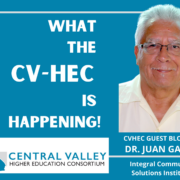Tag Archive for: John Spevak
This month’s “What The CV-HEC Is Happening” guest blog is presented by Joan Zoellner, M.A., Launch Years Initiative lead for the Charles A. Dana Center (University of Texas at Austin), co-facilitators of the CVHEC […]
This month’s “What The CV-HEC Is Happening” Blog takes a unique look at an unprecedented wave of leadership at five major Kern County education institutions: California State University, Bakersfield; Kern […]
Secondary education voices invited to join discussion Discussions to improve calculus pathways for STEM students amidst a pending deadline this summer continues with the third “Central Valley Way to AB1705 […]




